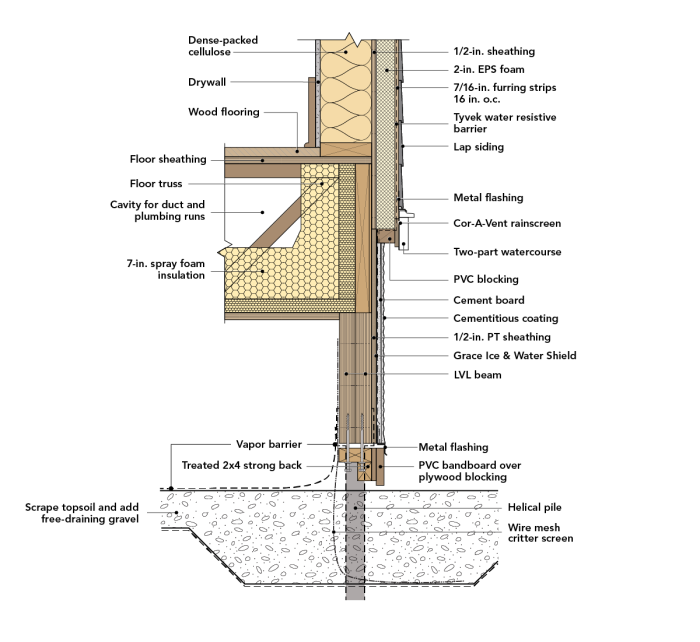
Helical piles, aka helical piers and screw piles, are being used more and more in residential construction. This is due to their versatility, installation speed/lower labor costs, and lighter site impact. We have used them successfully for several screened porches and decks and found them to be pretty quick and easy. Little to no excavation is needed when using piles, although replacing the topsoil with landscape fabric and free-draining gravel is a good idea.
Beyond porches and decks
We have a client who wants a straightforward addition to the back of the house. For additions we typically spec concrete frost walls with an unvented, insulated crawlspace. In this case, the site is extremely tight, with just 3 ft. 4 in. between house and lot line. Even with the neighbor’s allowance that we encroach a bit, large excavation equipment is out of the question, so a conventional foundation isn’t an option. With helical piles, the installation rig needs only 63 in. width and 6 ft. vertical clearance. So, we think helical piles are the best solution here.
Going this route presents a unique set of challenges—namely, how to detail a vented crawlspace with an insulated floor without foundation walls or a slab. The solution needs to accommodate duct runs and plumbing pipes; and we have to match architectural style/features with the existing house, which has above-grade foundation walls and a water course 2 ft. to 3 ft. above grade.
Helical pile puzzles
To address our primary concern with this foundation system—the ground heaving during freezing conditions—we have a two-part strategy. First, to reduce the likelihood of heaving, we will scrape the topsoil and dig a shallow trench around the perimeter; it will be filled with free-draining gravel. Second, to be prepared for the possibility of heaving, a treated 2×4 will be attached…
Weekly Newsletter
Get building science and energy efficiency advice, plus special offers, in your inbox.

This article is only available to GBA Prime Members
Sign up for a free trial and get instant access to this article as well as GBA’s complete library of premium articles and construction details.
Start Free TrialAlready a member? Log in














19 Comments
Christie,
I haven't used helical piers, but when I have done houses on concrete ones the complications were around insulating the main floor close to grade.
On your project I'm curious about the sequence of construction. The floor has spray foam against the plywood attached to the underside of the trusses, meaning that it will have it be installed from above - as will the ducts and plumbing in the truss cavity. How and when does this get done - specifically what is the relationship of this work to the sub-floor and walls that sit on it?
Hi Malcolm,
Yes the spray foam, ducts and plumbing will be installed from above. We'll install sub-floor at the perimeter to get our walls set and then come back and do the rest later. We're starting construction on this one in the next few months so we'll see how it goes.
You can do an unvented crawlspace with helicals. If you do an 18"x18" concrete beam sitting on the grade, with the heads of the piers embedded in the concrete and connected with rebar there is no need for excavation and the concrete can be brought in by wheelbarrow. From there you just go up as you would with any other poured foundation and insulate like any poured foundation. You can even do courses of block above if you want to go higher. Insulating the rim joists does require attention to detail because the foundation is so much thicker.
Depending on the construction you might be able to get away with fewer piers because an 18" reinforced concrete beam can span quite a distance.
I don't see why heaving would be a concern, the heads of the piers should be well below the frost line and well capable of resisting upward forces.
DC,
You would have to go a bit higher here. The minimum clearance under the joists is 2 ft, and you would want a bit more to accommodate foam on the ground.
So one course of block over the grade beams. That would actually make insulating the rim joists a lot easier.
I'm not an engineer, but when I did helicals on my house I hired an engineer and the 18x18 reinforced grade beam is how he did it. I don't know how he came up with that sizing.
DC,
It sure solves a lot of the problems that come with an open floor.
A grade beam is still susceptible to frost; the augurs on the bottom of helical piers are no match for the power of freezing waters' expansion. You could extend them down and insulate as a FPSF, but then you wouldn't need the helical piers in most cases.
I don't deal with frost heaving, it's not something we experience in DC. So I read up on it. I agree that the potential uplift would be greater than the augers could withstand.
It seems you could frost protect the beams with several inches of foam below. That would also provide something that could yield if there was frost heaving.
We may explore the concrete beam option in the future but this is something we wanted to try for this project.
Regarding the heaving, I'm not concerned with the piers moving. I am trying to prevent a destructive interaction between the ground and the exterior finishes immediately above it.
I'm a fan of the concept, even though I haven't used them for anything yet.
It would be interesting to compare the climate impact of the spray foam vs. the concrete in a conventional foundation. I bet the helical piles plus spray foam come out ahead with HFO spray foam.
I don't understand the concern about heaving--I would think you'd just go deep enough to avoid that concern.
I don't know why spray foam is needed. I have used similar designs several times now, with only cellulose insulation, or sometimes a layer of polyiso below the framing.
Agreed--my framing of the comparison doesn't really make sense. Helical piles can be a way to avoid both foam and concrete.
I've also done the math on helical piles vs. concrete piers with vertical rebar and footings, using the BEAM tool, and the carbon emissions are similar. Helical piers are much faster and usually less expensive to install, though.
Interesting. If you start counting workers driving to the job site, faster install also translates to lower emissions.
Michael - I think this could be done with cellulose but I don't love the idea of all that loose fill blowing around while we install ducts and plumbing. We'd have to net it somehow. Also, the air sealing would be a problem to solve, too. In theory the spray foam is doing that for us. I'm generally a fan of cellulose and EPS when I can but sometimes a little bit of spray foam goes a long way, and it is a small addition - 12' x 20'.
Christie, I designed and built an addition for my mother-in-law using a similar system; it's the lead image here: https://www.greenbuildingadvisor.com/article/all-about-helical-piles. It's about 500 sq.ft. and only has a single bathroom for plumbing. We netted and dense-packed it with cellulose, and used Zip sheathing below as the air control layer. At the one location where the plumbing drain was getting close to the Zip sheathing we added a layer of polyiso. I agree that spray foam can be a problem-solver, and keeping the plumbing from freezing is probably more important than having a few hundred additional kgs of carbon emissions.
Thank you for this article, the detail drawing, and the member comments. GBA, please continue including more adventurous helical pile strategies.
I've been experimenting with designs that use helical piles, LVL-grade beams, concrete-free construction, and foam-free construction...in tight urban environments. The helical piles are great for small infill lots, but I'm challenged by the required clearance needed between grade/gravel and the bottom of the floor joists/trusses. I either need to excavate down several more feet (which undoes many of the benefits of helical piles) or I need to elevate the entire ground floor off of grade (which subtracts from my available floor-to-floor heights under a fixed zoning envelope). I'll keep trying, but I'm still resorting to a frost-protected perimeter concrete grade beam with slab-less insulated plywood-on-grade floor.
That's an interesting challenge. I would think the need to excavate a few feet isn't so bad. But my other thought is that there are probably ways to engineer a floor system with shallower trusses or joists to make up for some of that problem. That's not easy, with a limited number of support points, but it would be an interesting challenge for a structural engineer. You also need the depth for insulation but it should be possible to get to down to no thicker than you need for that with enough piles and enough engineering.
It seems that would be an issue with anything other than slab on grade. And it really boils down to whether the value of the space gained by excavation is worth the cost.
Log in or become a member to post a comment.
Sign up Log in